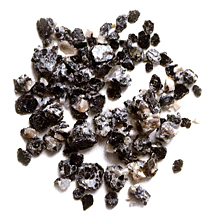DK Science: Mixtures
Almost everything is made of different substances mixed together. Things are only easy to recognize as mixtures if the PARTICLE SIZE of each substance is big enough to see. The flakes, nuts, and raisins in a bowl of cereal are a mixture that is easy to see. A fruit drink, though, doesn’t look like a mixture because the particles of fruit and water are so small. It is a type of mixture called a SOLUTION, made of different, very tiny particles dissolved (evenly spread out) in water.
Rock, sand, and seawater are all mixtures of the same substances – such as the minerals feldspar, mica, and quartz – but in different particle sizes. Rock contains these substances in chunks or veins; sand has them as small grains; and seawater contains them as tiny dissolved particles that are invisible to the eye. Rain and rivers dissolve the minerals as they wash over the rock on their way to the sea.
All rocks are mixtures of naturally occurring substances called minerals. Granite is a common rock made of three differently coloured minerals called feldspar, mica, and quartz. The pink grains in granite are feldspar, the black grains are mica, and the light grey, glass-like grains are quartz. Granite is usually about 75% feldspar, 5% mica, and 20% quartz. These proportions can vary and the rock often contains small amounts of other minerals as well.
There are many different types of mixtures, which are divided into groups based on how small their particles are. A mixture such as sand has a large particle size. Mud stirred in water is a type of mixture called a suspension; the particles are too small to see when mixed, but they eventually settle out. A mixture such as fog (water and air) is called a colloid; its particles are too small ever to settle out.
The particles of some mixtures are large enough to see without a microscope. When you look closely at a handful of sand, for example, you can make out the different coloured grains mixed together. Some sands have smaller grains than others. The smaller the grain size, the softer and more powdery the sand feels.
A colloid is a mixture containing tiny particles of one substance scattered throughout another substance, such as dye particles mixed with glass in a marble. The particles are smaller than those in a suspension, but larger than those in a solution. The particles are so small and light, they do not ever settle out.
Milk is made up of tiny globules of fat scattered throughout water. It is an example of an emulsion, a special type of colloid in which oils or fats are mixed with water to create a creamy liquid or paste. Other examples of emulsions are mayonnaise, emulsion paints, lipsticks, and face creams.
A solution is a mixture in which the different particles are tiny and are mixed completely evenly. Solutions are often made by dissolving a solid, such as sugar, into a liquid, such as water. The sugar is called the solute and the water is called the solvent. Water is the most common solute. Solutions can also be a liquid dissolved in another liquid, for example antiseptic liquid. This is water and alcohol. Or they can be a gas dissolved in another gas, such as oxygen dissolved in nitrogen in the air.
Wood’s Metal is found in automatic fire sprinklers. It is an alloy (mixture of metals) containing bismuth, lead, tin, and cadmium. This mix of metals has a low melting point of 71ºC (158ºF). It is used as a sensor in automatic fire sprinklers; if the temperature gets too high, the metal alloy melts and releases the water.

Another type of solution occurs when a gas is dissolved in a liquid. When a vitamin tablet is dissolved in water, carbon dioxide is produced to help the tablet dissolve quickly. Sparkling water is also a solution of carbon dioxide in water. When the gas is in solution, you cannot see it. It is only when the gas comes out of solution and bubbles to the surface of the liquid that you can see the gas that was once dissolved.

